How to Adapt Your Training to Weather Conditions
When the Weather Doesn't Cooperate—Train Smarter, Not Harder
There’s something humbling about setting out for a long ride, only to have a sudden gust of wind threaten to toss you sideways, or jumping into your running shoes, only to realize your city’s transformed into a slushy mess overnight. I’ve been there more times than I can count, and trust me—so have your competitors. That’s the beauty and the challenge of triathlon training: you’re not just preparing for a race, you’re learning how to train in whatever nature throws at you.
Whether it’s blistering heat, unexpected rain, or an icy spring morning, knowing how to adjust your training—not cancel it—can make the difference between falling behind or staying race-ready. And more importantly, it keeps you consistent and injury-free.
Understanding the Impact of Weather on Performance
Let’s be honest—weather can turn even the best-laid plans upside down. A long tempo run turns into a survival shuffle when heat and humidity spike. A windy ride that was supposed to be steady becomes an unintended interval session. Or maybe your pool closes because of lightning, and suddenly your key swim session is out.
But here’s the thing: weather doesn’t have to derail your training. You just need to learn how to respond—not react. That means understanding how different conditions affect your body, your gear, and your safety. From there, it’s about making intentional adjustments rather than just powering through.
I often tell my athletes: the weather isn’t a roadblock. It’s a training variable, just like pace or intensity.
Training in Heat: Dial Down the Ego, Dial Up the Fluids
Hot days can be deceptive. You feel great in the first 15 minutes, then suddenly your heart rate is spiking, your pace drops, and your hydration plan feels way off. That’s normal. Your body works harder in the heat—not just to move, but to cool itself. That means every workout feels harder at the same pace.
What works? Start early, slow your pace, and increase hydration. Don’t aim for perfection. Aim for completion, especially on long sessions. I’ve had athletes reduce pace by 30 seconds per km in the heat and still get a better aerobic benefit without the meltdown.
You’re not failing if you adjust. You’re adapting. And that’s what builds long-term fitness.
Cold, Wind, and Wet: Don’t Let the Elements Win
Cold weather doesn’t just test your gear—it tests your motivation. I’ve had mornings where I stared at the frost on my windshield for five minutes, debating whether to head to the trainer or layer up and ride. The answer? It depends on the goal of the session.
Short, high-intensity sessions in cold wind? Move them indoors. Long, low-intensity aerobic sessions? With the right layers, they’re great outdoors. Just make sure you warm up properly and stay dry. Wet plus cold is a dangerous combo.
And when it comes to wind, here’s a tip I give all my riders: start your ride into the wind, finish with it at your back. You’ll thank yourself on the way home.
Rain and Thunderstorms: Know the Line Between Tough and Reckless
There’s training through discomfort, and there’s training through danger. Rain can be fine—if you’re experienced and on the right roads. But thunder, lightning, poor visibility, or slick trails? That’s where we shift to Plan B.
I’ve designed dozens of alternate indoor sessions for days like this—modified tempo runs on the treadmill, indoor cycling intervals that mimic race terrain, or even swim-specific strength workouts when the pool’s closed.
The key isn’t just having a Plan B—it’s being okay with it. You don’t lose fitness by pivoting. You lose fitness by skipping altogether or getting injured.
How I Coach Athletes to Stay Flexible
One of the most important lessons I teach is that being weather-resilient starts with being schedule-flexible. If Tuesday’s ride looks miserable and Friday’s sunny? Switch them. Build that flexibility into your training calendar from the start.
When I’m building programs in TrainingPeaks, I use color-coded weather overlays and alerts. That way, we can forecast and adjust in advance. Athletes are empowered to look ahead, not just at what’s written—but what’s realistic.
And sometimes, the weather is the perfect excuse to rest. A storm rolls in? Great—take the recovery day early. Move your big day to Saturday. Listen to the forecast and your body.
What the Pros Do (That You Can Too)
Some of the best professional triathletes I know don’t just “grind through” bad weather. They build options into every week. They have go-to indoor sessions, treadmill fallback plans, and gear that keeps them riding even when conditions are questionable.
The difference? They don’t see it as weakness—they see it as preparation. Because come race day, the weather won’t care how ideal your training was. It will only care how adaptable you’ve become.
Let the Weather Shape You, Not Stop You
If there’s one thing triathlon teaches us, it’s how to adapt. Weather might be unpredictable, inconvenient, and sometimes downright frustrating—but it’s also an opportunity to grow tougher, smarter, and more resilient.
Whether you're facing an unexpected heatwave, a soggy long ride, or a frozen lake in spring, your training doesn’t have to suffer. With the right mindset and a few practical strategies, you can turn every weather challenge into a confidence builder.
Remember: it’s not about training through perfect conditions. It’s about showing up anyway—and learning how to adjust when things aren’t perfect. That’s what makes a race-day-ready triathlete.


